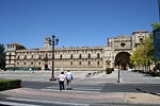
Convent of San Marcos, León
Encyclopedia
The convent of San Marcos in León, Spain
is today an operating luxury parador
hotel. It also contains a consecrated church and museum, and is one of the most important monuments of the Renaissance
in Spain. It is one of the greatest architectural jewels of León, together with the Cathedral
, the Basilica of San Isidoro
and la Casa Botines. It has a highly ornamental plateresque
facade.
León, Spain
León is the capital of the province of León in the autonomous community of Castile and León, situated in the northwest of Spain. Its city population of 136,985 makes it the largest municipality in the province, accounting for more than one quarter of the province's population...
is today an operating luxury parador
Parador
A parador , in Spain and other Spanish-speaking countries, is a kind of luxury hotel, usually located in a historic building such as a monastery or castle. Parar means to stop, halt or stay.- Paradores de Turismo de España :...
hotel. It also contains a consecrated church and museum, and is one of the most important monuments of the Renaissance
Renaissance
The Renaissance was a cultural movement that spanned roughly the 14th to the 17th century, beginning in Italy in the Late Middle Ages and later spreading to the rest of Europe. The term is also used more loosely to refer to the historical era, but since the changes of the Renaissance were not...
in Spain. It is one of the greatest architectural jewels of León, together with the Cathedral
León Cathedral
Santa María de León Cathedral, also called The House of Light or the Pulchra Leonina is situated in the city of León in north-western Spain. It was built on the site of previous Roman baths of the 2nd century which, 800 years later, king Ordoño II converted into a palace.The León Cathedral,...
, the Basilica of San Isidoro
Basilica of San Isidoro
The Basilica of San Isidoro is a church in León, Spain, located on the site of an ancient Roman temple. Its Christian roots can be traced back to the early 10th century when a monastery for Saint John the Baptist was erected on the grounds....
and la Casa Botines. It has a highly ornamental plateresque
Plateresque
Plateresque, meaning "in the manner of a silversmith" , was an artistic movement, especially architectural, traditionally held to be exclusive to Spain and its territories, which appeared between the late Gothic and early Renaissance in the late 15th century, and spread over the next two centuries...
facade.

